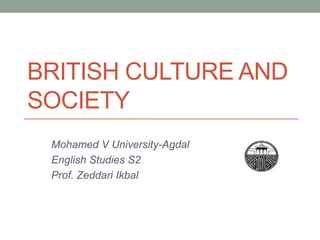
British culture and society full
- 1. BRITISH CULTURE AND SOCIETY Mohamed V University-Agdal English Studies S2 Prof. Zeddari Ikbal
- 2. England • England - St. George (23rd April) and the Rose The national flower of England is the rose. The flower has been adopted as England’s emblem since the time of the Wars of the Roses - civil wars (1455-1485) between the royal house of Lancaster (whose emblem was a red rose) and the royal house of York (whose emblem was a white rose).
- 3. Northern Ireland • Northern Ireland - St. Patrick (March 17th) and the Shamrock The national flower of Northern Ireland is the shamrock, a three- leaved plant similar to clover. An Irish tale tells of how Patrick used the three-leafed shamrock to explain the Trinity. He used it in his sermons to represent how the Father, the Son, and the Holy Spirit could all exist as separate elements of the same entity. His followers adopted the custom of wearing a shamrock on his feast day.
- 4. Wales • Wales - St. David (March 1st) and the Daffodil The national flower of Wales is the daffodil, which is traditionally worn on St. David’s Day. The vegetable called leek is also considered to be a traditional emblem of Wales.
- 5. Scotland • Scotland - St. Andrew (Nov 30th) - the Thistle and Scottish Bluebell The national flower of Scotland is the thistle, a prickly-leaved purple flower which was first used in the 15th century as a symbol of defence.
- 8. Country Area (sq km) Population England 129,634 49,753,000 Scotland 77,179 5,119,000 Wales 20,637 2,937,000 Northern Ireland 13,438 1,692,000
- 10. The southeast • A mixture of lowlands and chains of small hills. • A horseshoe-shaped ring of chalk hills known as the Downs run down to the sea through Kent,The garden of England, and Sussex., • The South Downs reach the coast near Brighton, the North Downs at Dover, where they end in the famous white cliffs.
- 11. The south west • The southwest is known for farming, fishing and dairy products. The region covers most of an area known as the West Country. • Rocky, moorlands exmoor and dartmoor • Salisbury Plain occupies most of the central part of southern England. Many people travel to see Stonehenge there. • Bristol is a major city,
- 12. Stonehenge on Salisbury Plain
- 13. East anglia/East of England • The East of England is a very flat area, so it is important for agriculture (cereals, sugarbeet, fruit and vegetables, turkeys, sheep and cattle), • Cambridge, Norwich ipswich,
- 14. West Midlands/the black country • A mixture of valleys, hills, and moors. • Birmingham, "city of 1001 trades », is a major centre of industry, • Stoke-on-Trent is the centre of the ceramics industry. • Stratford-upon-Avon in Warwickshire is famous for the birthplace of the writer William Shakespeare.
- 15. The East Midlands • The East Midlands is the fourth largest region in England. • Most of the East Midlands is low-lying. • Nottingham and Leicester are known for their chinaware. • Grimsby is a fishing port
- 16. North West • The pennines has large deposits of coal iron ore, • Manchester and Liverpool are the Northwest's largest cities and both are important ports.(cotton goods, 19th c) • Liverpool is also famous as being the home of the Beatles.
- 17. Yorkshire and Humber • Engineering and textiles are the region's two top industries, and are concentrated in West and South Yorkshire. • Sheffield's silver and steel industries have a worldwide name. • For many years Yorkshire's coalfields provided much of the fuel used in British industry, but most mines have now closed.
- 18. • Historically, Northumberland North East mined iron core, lead and silver. Northumberland's shipbuilding and glass- making have also declined. • Now the county produces electrical machinery and pottery. • There are manufacturing and engineering industries in parts of Durham and Tyne and Wear.
- 19. • North of the border with england are the southern uplands,sheepfarming, • 80 per cent of the popoulation live in the Central plain • The highlands( tourism and whisky production)
- 20. Major Scottish cities. • Glasgow is associated with heavy industry and poor housing (the Gorbals), • A city of artistic heritage in design and architecture • Religious divisions due Immigration from Northern Ireland. • Edinburgh, the Athens of the North, is the capital of Scotland. • It has a middle-class image as it is associated with scholarship, law and administration. • The Annual Edinburgh Festival of the arts.
- 21. Wales • The south east is most heavily populated • Cardiff is the capital with a population of about a quarter a million • It used to be an industrial area • The rest of wales is mountainous • The north is closer to Liverpool in England • Mid-wales is closer to the West Midlands in England • Snowdon is "probably the busiest mountain in Britain.” • It is located in the largest National park.
- 22. Northern Ireland • Belfast is known for the manufucture of linen • A shipbuilding city. • The rest of Northern Ireland is agricultural with beautiful scenery. • The Giant’s Causeway on the north coast is specatcular
- 24. What do we call someone from these cities? • City Nickname • Cornwall …………… • Manchester …………… • Nottingham …………… • Sheffield …………… • Birmingham …………… • London …………… • Newcasle …………… • Glasgow …………… • Liverpool ……………
- 25. • City Nickname • Cornwall cornish • Manchester mancunian • Nottingham Nottinghamian • Sheffield Sheffielder • Birmingham Brummy • London Londoner • Newcasle Geordie • Glasgow Glaswegian, • Liverpool liverpudlian
